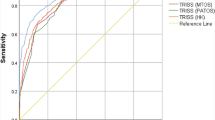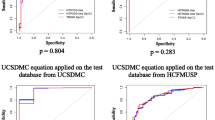Abstract
Background
Our purpose was to validate the performance of the ISS, NISS, RTS and TRISS scales as predictors of mortality in a population of trauma patients in a Latin American setting.
Materials and methods
Subjects older than 15 years with diagnosis of trauma, lesions in two or more body areas according to the AIS and whose initial attention was at the hospital in the first 24 h were included. The main outcome was inpatient mortality. Secondary outcomes were admission to the intensive care unit, requirement of mechanical ventilation and length of stay. A logistic regression model for hospital mortality was fitted with each of the scales as an independent variable, and its predictive accuracy was evaluated through discrimination and calibration statistics.
Results
Between January 2007 and July 2015, 4085 subjects were enrolled in the study. 84.2% (n = 3442) were male, the mean age was 36 years (SD = 16), and the most common trauma mechanism was blunt type (80.1%; n = 3273). The medians of ISS, NISS, TRISS and RTS were: 14 (IQR = 10–21), 17 (IQR = 11–27), 4.21 (IQR = 2.95–5.05) and 7.84 (IQR = 6.90–7.84), respectively. Mortality was 9.3%, and the discrimination for ISS, NISS, TRISS and RTS was: AUC 0.85, 0.89, 0.86 and 0.92, respectively. No one scale had appropriate calibration.
Conclusion
Determining the severity of trauma is an essential tool to guide treatment and establish the necessary resources for attention. In a Colombian population from a capital city, trauma scales have adequate performance for the prediction of mortality in patients with trauma.



Similar content being viewed by others
References
Lefering R (2012) Trauma scoring systems. Curr Opin Crit Care 18(6):637–640
Safety CoMAoA (1971) Rating the severity of tissue damage. I. The abbreviated scale. JAMA 215(2):277–280
Kim YJ (2012) Injury severity scoring systems: a review of application to practice. Nurs Crit Care 17(3):138–150
Russell RJ, Hodgetts TJ, McLeod J, Starkey K, Mahoney P, Harrison K et al (2011) The role of trauma scoring in developing trauma clinical governance in the Defence Medical Services. Philos Trans R Soc Lond B Biol Sci 366(1562):171–191
Baker SP, O’Neill B, Haddon W Jr, Long WB (1974) The injury severity score: a method for describing patients with multiple injuries and evaluating emergency care. J Trauma 14(3):187–196
Osler T, Baker SP, Long W (1997) A modification of the injury severity score that both improves accuracy and simplifies scoring. J Trauma 43(6):922–925
Tohira H, Jacobs I, Mountain D, Gibson N, Yeo A (2012) Systematic review of predictive performance of injury severity scoring tools. Scand J Trauma Resusc Emerg Med 20:63
Champion HR, Sacco WJ, Copes WS, Gann DS, Gennarelli TA, Flanagan ME (1989) A revision of the Trauma Score. J Trauma 29(5):623–629
Champion HR, Sacco WJ, Hunt TK (1983) Trauma severity scoring to predict mortality. World J Surg 7(1):4–11
Gennarelli TA, Wodzin E (eds) (2005) The abbreviated injury scale 2005. Association for the Advancement of Automotive Medicine, Barrington, IL
Steyerberg EW (2009) Clinical prediction models: a practical approach to development, validation, and updating, vol xxviii. Springer, New York, p 497
Vergouwe Y, Steyerberg EW, Eijkemans MJ, Habbema JD (2005) Substantial effective sample sizes were required for external validation studies of predictive logistic regression models. J Clin Epidemiol 58(5):475–483
McNeil BJ, Hanley JA (1984) Statistical approaches to the analysis of receiver operating characteristic (ROC) curves. Med Decis Mak Int J Soc Med Decis Mak 4(2):137–150
Hosmer DW, Hosmer T, Le Cessie S, Lemeshow S (1997) A comparison of goodness-of-fit tests for the logistic regression model. Stat Med 16(9):965–980
Schluter PJ (2011) The Trauma and Injury Severity Score (TRISS) revised. Injury 42(1):90–96
Bouzat P, Legrand R, Gillois P, Ageron FX, Brun J, Savary D et al (2016) Prediction of intra-hospital mortality after severe trauma: which pre-hospital score is the most accurate? Injury 47(1):14–18
Chawda MN, Hildebrand F, Pape HC, Giannoudis PV (2004) Predicting outcome after multiple trauma: which scoring system? Injury 35(4):347–358
Smith BP, Goldberg AJ, Gaughan JP, Seamon MJ (2015) A comparison of Injury Severity Score and New Injury Severity Score after penetrating trauma: a prospective analysis. J Trauma Acute Care Surg 79(2):269–274
Zhao XG, Ma YF, Zhang M, Gan JX, Xu SW, Jiang GY (2008) Comparison of the new injury severity score and the injury severity score in multiple trauma patients. Chin J Traumatol 11(6):368–371
Husum H, Strada G (2002) Injury severity score versus new injury severity score for penetrating injuries. Prehospital Disaster Med 17(1):27–32
Tay SY, Sloan EP, Zun L, Zaret P (2004) Comparison of the New Injury Severity Score and the Injury Severity Score. J Trauma 56(1):162–164
Lavoie A, Moore L, LeSage N, Liberman M, Sampalis JS (2004) The New Injury Severity Score: a more accurate predictor of in-hospital mortality than the Injury Severity Score. J Trauma 56(6):1312–1320
Royston P, Moons KG, Altman DG, Vergouwe Y (2009) Prognosis and prognostic research: developing a prognostic model. BMJ 338:b604
Ordonez CA, Pino LF, Tejada JW, Badiel M, Loaiza JH, Mata LV et al (2012) Experience of two first level hospitals in the southwest region of Colombia on the implementation of the Panamerican Trauma Society International Trauma Registry. Revista do Colegio Brasileiro de Cirurgioes 39(4):255–262
Carreiro PR, Drumond DA, Starling SV, Moritz M, Ladeira RM (2014) Implementation of a trauma registry in a Brazilian public hospital: the first 1,000 patients. Revista do Colegio Brasileiro de Cirurgioes. 41(4):251–255
Norouzi V, Feizi I, Vatankhah S, Pourshaikhian M (2013) Calculation of the probability of survival for trauma patients based on trauma score and the injury severity score model in fatemi hospital in ardabil. Arch Trauma Res 2(1):30–35
Wui LW, Shaun GE, Ramalingam G, Wai KM (2014) Epidemiology of trauma in an acute care hospital in Singapore. J Emerg Trauma Shock 7(3):174–179
Cook A, Weddle J, Baker S, Hosmer D, Glance L, Friedman L et al (2014) A comparison of the injury severity score and the trauma mortality prediction model. J Trauma Acute Care Surg 76(1):47–52
Hildebrand F, Lefering R, Andruszkow H, Zelle BA, Barkatali BM, Pape HC (2015) Development of a scoring system based on conventional parameters to assess polytrauma patients: PolyTrauma Grading Score (PTGS). Injury 46(Suppl 4):S93–S98
Heim C, Bosisio F, Roth A, Bloch J, Borens O, Daniel RT et al (2014) Is trauma in Switzerland any different? epidemiology and patterns of injury in major trauma—a 5-year review from a Swiss trauma centre. Swiss Med Wkly 144:w13958
Reiter A, Mauritz W, Jordan B, Lang T, Polzl A, Pelinka L et al (2004) Improving risk adjustment in critically ill trauma patients: the TRISS-SAPS Score. J Trauma 57(2):375–380
Acknowledgements
Supported by “Comité para el Desarrollo de la Investigación (CODI)” Grant 2571 Convocatoria Programática en Ciencias Biomédicas y de la Salud 2012–2013 Universidad de Antioquia.
Author information
Authors and Affiliations
Corresponding author
Ethics declarations
Conflict of interest
None.
Rights and permissions
About this article
Cite this article
Valderrama-Molina, C.O., Giraldo, N., Constain, A. et al. Validation of trauma scales: ISS, NISS, RTS and TRISS for predicting mortality in a Colombian population. Eur J Orthop Surg Traumatol 27, 213–220 (2017). https://doi.org/10.1007/s00590-016-1892-6
Received:
Accepted:
Published:
Issue Date:
DOI: https://doi.org/10.1007/s00590-016-1892-6




